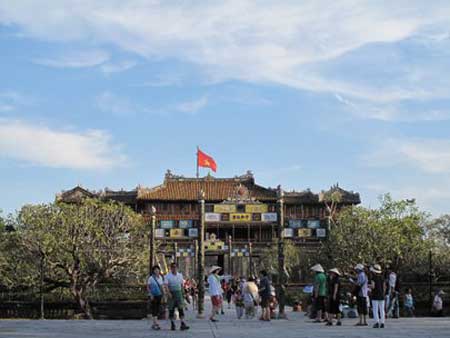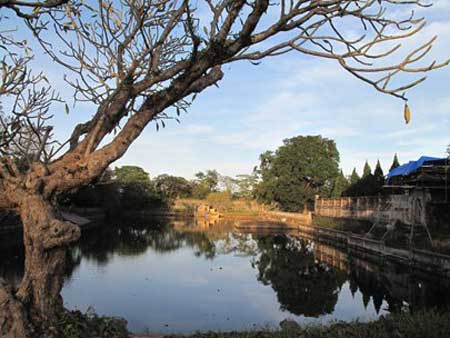When visiting Hue City, tourists proudly march to the former Hue Imperial Palace to explore the royal architecture for two reasons: to admire its ancient charm as well as to review the country’s history. It is a huge attraction to so many travelers for a number of years, especially since the citadel was recognized as a World Cultural Heritage Site by UNESCO almost two decades ago.
Just as a reminder, construction of the Hue royal city started in 1805 under the reign of King Gia Long and was completed in 1832 under King Minh Mang, on the northern bank of the Huong (Perfume River). It is a huge complex covering an area of 520ha and comprising three circles of ramparts, Kinh Thanh Hue (Hue Capital Citadel), Hoang Thanh (Royal Citadel) and Tu Cam Thanh (Forbidden Citadel).
 Tourists flock to Tu Cam Thanh.
Tourists flock to Tu Cam Thanh.
As far as architecture is concerned, the royal citadel of Hue was built in the style of the French military architect Vauban in combination with Oriental palace architecture. So to discover the whole site, tourists may need half a day for a Vietnam tourism. However, not one second will be wasteful as it will be a trip they will never forget.

One of the gates of Hue Imperial Citadel in early morning in Hue City.
The first stop-over is the exterior circle. With a square shape, it is almost 10km in circumference, 6m high, 21m thick, with 10 entrances. On the top of the walls, 24 bastions are established for defensive purposes. Is there too many to visit on a scorching hot or rainy day? Well it is up to you but remember you might only visit this magnificent area once in a lifetime, so keep calm and enjoy the splendor. The outermost boundary has stayed intact for the last two centuries and still has its original design with nearly 140 small and large constructions worthy of exploration.
Now we move further into the second circle, the Hoang Thanh (Royal citadel), the most important part of the Citadel, which started in 1804 and was completed in 1833, under King Ming Mang’s reign. The Citadel, which is more than 600m long on each side, was built with bricks 4m high, and 1m thick. Around the citadel is a protective trench. Tourists can get access to the Imperial Citadel through four entrance gates.

A romantic view on Kim Thuy Lake at sunset.
In the past, Ngo Mon Gate was only reserved for the King. The Royal Citadel consists of more than 100 fascinating architectural works divided into numerous sections such as the Ngo Mon Gate and the Thai Hoa Palace used for various grand ceremonies, shrines of the Kings under Nguyen Dynasty, internal affairs office with a storehouse for precious objects, workshop for manufacturing various useful articles and the Kham Van Palace and Co Ha Garden is where the princes studied and relaxed.
Passing through Hoang Thanh, we enter Tu Cam Thanh (Forbidden Citadel). Situated inside the Imperial Citadel complex, behind the Throne Palace, the Purple Forbidden Citadel was reserved for Emperor Gia Long and his family. Built in early 1803 under his reign, it was initially named Cung Thanh. In 1821, it was renamed Tu Cam Thanh.
 Ky Dai (Flag Tower).
Ky Dai (Flag Tower).
The whole site consists of 50 architectural constructions of different sizes and seven gates for facilitating the entrance and exit. Dai Cung Mon (the Great Palace Gate) is in the front side and was reserved for the Kings. Can Chanh Palace was the place for daily working life of Emperors. Can Thanh (Emperor’s Private Palace) and Khon Thai Residence (Queen’s Private Apartment) were reserved for Queens. There are still many other sections, for instance, Duyet Thi Duong house (Royal Theatre), Thuong Thien (the kitchen for the Kings’ food), Thai Binh Lau (King’s reading room), all of which are of great architectural value, luring thousands of visitors who are interested in feudal architecture.
The citadel is also decorated with romantic ideals behind it with many giant green trees, small lakes and plumeria. Especially visiting the site at the sunset moment, you will see the ancient golden color of walls under the golden of sun beams in harmony. All will take to you a world of peace, stillness and glorious pride in Vietnam’s history.
Have you ever been there? Taking a glimpse onto the special feudal relics of immense architectural and cultural values, you will surely know you more or less love the traditional and classical side of Vietnam. As time goes by, thousands of changes in history have occurred but the precious historical and classical beauty of the nation will never be gone, just faded over time.
Source: SGT
(84-63) 3 826042 – (84-63) 3 511142
No 54 Nguyen Dinh Chieu, Ham Tien Central Mui Ne Beach Binh Thuan Vietnam
523 To Hien Thanh District 10 Ho Chi Minh City Vietnam
Ha Long Halong City Quang Ninh Vietnam
A13 Hung Thong 2 Halong City Quang Ninh Vietnam




